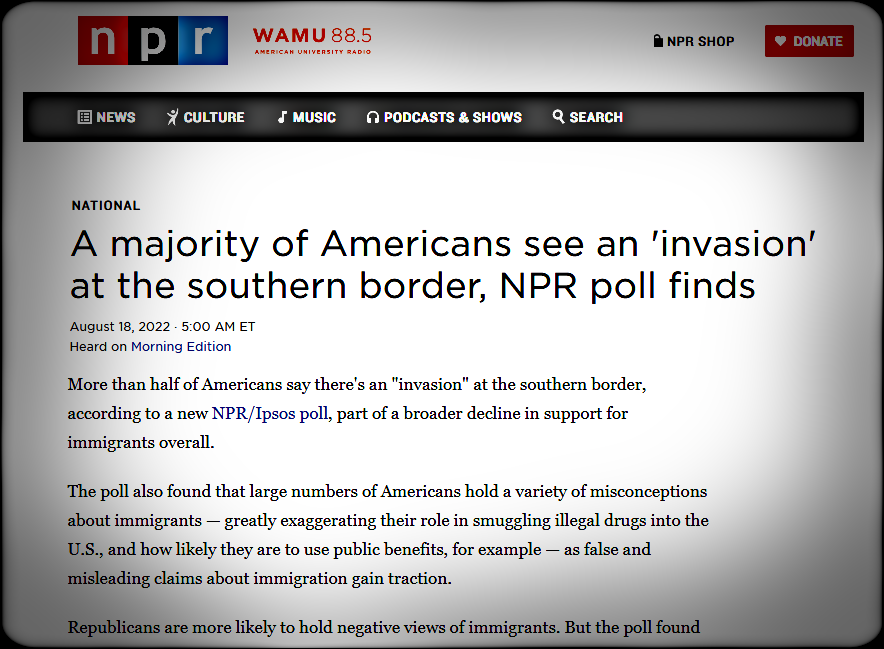NPR Falsely Claims High Immigrant Welfare Use is a Myth
A new NPR opinion poll (by Ipos) and accompanying article argues that many Americans wrongly believe immigrants use “public benefits” at higher rates than the U.S.-born. NPR should have done its homework, as it is certainly not “false and misleading” to think that immigrant households make heavy use of welfare programs. In fact, it is well established that immigrant-headed households access most public benefit programs at higher rates than native-headed households.
NPR cites no data to support its position. Instead, it simply states that many immigrants are barred from welfare programs. However, most legal immigrants have lived in the country long enough to access welfare or have become citizens. Moreover, all legal immigrants and even illegal immigrants can receive benefits on behalf of their U.S.-born children. An analysis of the Census Bureau’s Survey of Income and Program Participation (SIPP) by the Center published last year, based on data collected before Covid-19, shows that immigrant households use nearly every type of welfare program at higher rates than U.S.-born households.
The heavy use of welfare programs by immigrant households is not because immigrants are lazy and don’t work, nor it is because they all came to get welfare. Rather, a larger share of immigrants have modest levels of education and are more likely to be poor. As a result, immigrants are more likely than the U.S.-born to turn to taxpayers to support themselves or their children.
In our prior analysis we looked at the following programs: Supplemental Security Income (SSI), Temporary Assistance to Needy Families (TANF), the Earned Income Tax Credit (EITC), the Women, Infants, and Children (WIC) food program, free or subsidized school breakfast and lunch, food stamps (officially called the Supplemental Nutrition Assistance Program or SNAP), Medicaid, public housing, and rent subsidies. All of these are means-tested anti-poverty programs. (In an effort inflate the use rate of the U.S.-born, some advocates of high immigration have tried to argue that social insurance programs like Social Security and Medicare should be counted as welfare. But these programs are not means-tested – they are open to all participants who pay in to the system – and are therefore not welfare as traditionally defined.)
Summary information from our prior analysis:
- In 2018, 49 percent of households headed by all immigrants — naturalized citizens, legal residents, and illegal immigrants — used at least one major welfare program, compared to 32 percent of households headed by the native-born.
- Among households headed by non-citizens, 55 percent used at least one welfare program. Non-citizens in the SIPP include those in the country legally (e.g. green card holders) and those in the country illegally.
- Welfare use dropped somewhat to 45 percent for all immigrant households and to 51 percent for non-citizen households if cash payments from the Earned Income Tax Credit (EITC) are not counted as welfare. This compares to 28 percent for native households excluding the EITC. EITC recipients pay no federal income tax and, like other welfare, it is a means-tested, anti-poverty program, but unlike other programs one has to work to receive it.
- Compared to native households, immigrant-headed households had especially high use of Medicaid (33 percent vs. 20 percent for natives) and food programs (31 percent vs. 19 percent for natives).
- Including the EITC, 25 percent of all immigrant-headed households and 27 percent of non-citizen-headed households received cash welfare, compared to 18 percent of native households. If the EITC is not included, then cash receipt by all immigrant and non-citizen households was only slightly higher than that of the native-born.
- Welfare use is high for both newly arrived immigrants and long-time U.S. residents. Of households headed by an immigrant who had lived in the United States for 10 years or less, 44 percent used at least one program. Of those in the country more than 10 years, 50 percent accessed one or more programs.
- Among households headed by a non-citizen who had lived in the United States for 10 years or less, 40 percent used at least one major program and for those in the country more than 10 years it was 62 percent.
- Factors that tend to lessen the effectiveness of restrictions on immigrant welfare use include:
- Non-citizens (including illegal immigrants) can receive benefits on behalf of their U.S.-born children who are awarded U.S. citizenship and full welfare eligibility at birth.
- Most legal immigrants have been in the country long enough to qualify for welfare
- The bar does not apply to all programs, nor does it always apply to non-citizen children
- Naturalized adults and children have the same welfare eligibility as the U.S.-born
- Some states provide welfare to otherwise ineligible immigrants on their own




